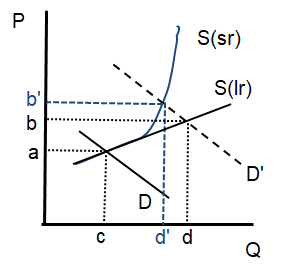Recently, I’ve been saying occasionally that “shortages are unmeasured inflation.” In some conversations I have had, it became apparent to me that people were taking this statement as being a throwaway line: “inflation is bad, shortages are bad, therefore they’re kinda the same.” But what I mean is actually more profound than that, and so I figured I would explain and illustrate, and hopefully thereby to convince.
Let’s use some charts.
What has happened since the large increase in federal spending and transfer payments were implemented in several waves since the shutdown began is that demand in many product markets has shifted outward. This implies that output “Q” moves from c to d while the price level “P” moves from a to b. [1]

So a strong increase in demand causes an increase in the quantity exchanged at the new equilibrium, and an increase in the price of the good or service at that equilibrium. This is the nice, smooth, continuous markets, instantaneous-adjustment picture from Econ 101. It’s also not the way the real world works, especially with large shifts in demand.
If price only adjusts partially, maybe if “anchored inflation expectations” or a fear of being accused of gouging restrained vendors from raising prices enough to ration the available supply, then a shortage results. This is the same thing which occurs classically if a price cap is instituted from the outside. Now price moves up from a only to b', but the quantity demanded at that price is at d'. Thus, the bracket on the chart below shows the size of the shortage at that price, where consumers want d but suppliers can’t/won’t provide that much.

Note that this shortage is a direct substitute for the increase in price that would otherwise happen if prices could instantly and fully adjust. Moreover, the picture is somewhat worse in the short-term because the supply curve—in the short-term—is much more inelastic at some point (because, for example, no matter how high the price gets we can’t deliver more used cars in the short run).
So, in the picture below the short-run supply curve in blue implies that the large increase in demand pushes prices to b’ with output only at d’, until supply eventually adjusts to the long-run supply curve S(lr), when we end up in the new market-clearing equilibrium.

In this case, the difference between b and b’ is “transitory” inflation, caused by temporary supply constraints. But note that in this picture, there is no perceived shortage. The market clears at b’ and d’. In other words, the conditions leading to the “transitory” increase inflation are not the same ones leading to the shortages.
We can combine these; if in the last picture above vendors also constrain prices to b, then there is a shortage as the quantity demanded stays up at d rather than at the market-clearing level d’. But, again, in that instance the shortage reflects the fact that prices should have adjusted to b’ but did not. Also in that case, it would be inaccurate to claim that the inflation was transitory, since prices should remain at b even when the supply eventually adjusts to the long-run equilibrium. It would be the shortage that was transitory.
In theory, if we knew the shapes of the curves of supply and demand for each product market, we could estimate how much higher prices would be at equilibrium and therefore how much additional inflation the shortage implies. We could directly translate the shortages to an “equilibrium” price level and therefore inflation.
It strikes me as plausible that we could develop a rough estimate of such a number, but I leave that to the Ph.D. candidates looking for dissertation topics. In the meantime, just remember that with inflation over 5% presently and shortly headed above 6%…the inflation rate is understated, and we know that because there are lots of shortages.
[1] If the deficits, funded by Fed purchases of Treasuries, had just offset the loss in incomes due to the shutdown—perfectly, across all individual markets—then there would have been no demand shift and no net change in output or prices.
And if the deficits had not been accompanied by an increase in the Fed balance sheet, then it would have been individuals buying the bonds and so the only effect would have been because the marginal propensity to consume of the people receiving transfer payments is higher than the marginal propensity to consume of the people buying the bond issuance.
But in this column I’m trying not to muddy the discussion with the argument of whether we need both fiscal and monetary stimulus to cause inflation. I’m just focused on the narrow question of what it means when I say “shortages are unmeasured inflation.”
